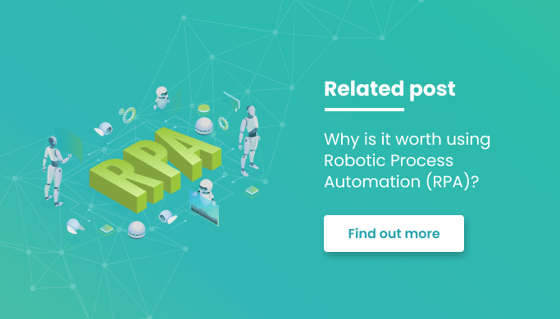Trends and use cases that will evolve RPA (Robotic Process Automation) in 2023

- RPA
- ROBOTIC PROCESS AUTOMATION
2022 has been an exciting year for robotic process automation, starting with the emerging phenomenon of intelligent automation through the expanding number of executing automation in the Cloud. Many trends in 2022 were primarily adaptive for medium-sized companies but they encouraged large enterprises to make the switch as well. As we are getting closer to 2023, it's time to identify what RPA has for us in the next year. Time and money are to most valuable items businesses focus on to reach their long-term goals, and it is no surprise that RPA was made to contribute to these purposes. As we already know, Robotic Process Automation (RPA) focuses on automating repetitive processes based on rules to imitate human interactions with different applications simultaneously.
Time and money are to most valuable items businesses focus on to reach their long-term goals, and it is no surprise that RPA was made to contribute to these purposes. As we already know, Robotic Process Automation (RPA) focuses on automating repetitive processes based on rules to imitate human interactions with different applications simultaneously.
Robots are widely implemented in different kinds of industries - such as Automotive, Finance, Banking, Manufacturing, Retail, Healthcare, and so much more - to free people from repetitive, monotonous tasks to increase efficiency while reducing human-made errors. The list of utilizing RPA is endless, which is why Automation is still exciting to implement in 2023.
|
|
Top 3 RPA trends that will dominate in 2023
|
|
Increased adoption of RPA among SME businesses
Many of us identify RPA as an asset that requires high initial investment to reach ROE in a shorter period. In reality, the market of RPA is so volatile and expanded that it pushed vendors to divert to low-cost RPA services without quality deterioration. The pandemic was a major trigger that enhanced the adoption of robotic process automation across diverse segments; therefore it's no surprise that RPA became a tool for small and medium-sized businesses to decrease their expenses without the need to start mass downsizing in the organization.
The rise of Intelligent Automation (IA)
Initially, RPA robots were used to automate simpler business processes, but as the problems to be solved became more complex, the limits of RPA were pushed. Both RPA and intelligent automation (IA) contribute to improving the efficiency of business processes, but their applications are very different. In intelligent automation, robots make real-time decisions based on data, where machine learning (ML) is added to business intelligence in the operation of robots. Typically, IA robots do not perform repetitive, routine tasks but provide an automation solution where a fast and deep understanding of data is key. IA is currently widely implemented in the banking and financial sector, i.e., asset management firms use IA robots to analyze and monitor the performance of their client's investments, and banks use IA to filter out signs of irregular activities. Intelligent automation is a trend to look forward to in 2023, as it will shape the future of RPA quickly.
RPA becomes and essential part of ERP (Enterprise Resource Planning) systems
An ERP system unifies and automates business operations by extracting user data, performing and scheduling procedures or maintaining data records. It is a major challenge for organizations to speed up legacy systems while planning consciously with financial resources. RPA has the existing compatibility with legacy and modern systems, RPA bots are the most cost-effective solutions to scale companies with enhanced capacity of current resources. Using RPA for ERP-driven procedures gives the corps a competitive edge to scale their processes without significant disruption in management. Moreover, RPA bots handle time-consuming, repetitive tasks with higher velocity and accuracy, allowing humans to focus on further higher value-added tasks.
|
|
Top 3 RPA use cases that will expand in 2023
|
|
Streamlining accounts payable processes
The accounts payable team handles vendor invoices, bills, records, and short-term debts. Many parts of their processes are time-consuming, repetitive, and incredibly sensitive to mistakes, and when it happens, the company realizes a significant fall in day-to-day functioning. Despite the high fault rate, companies still rely on manual employee intervention and paper invoices to process payments. RPA significantly impacts time and cost savings in automating accounts payable processes. By shifting manual tasks from human workers to robots, banking and financial sector companies can increase overall efficiency while decreasing expenses. RPA in accounts payable refers to using technology to control and automate rule-based processes without human intervention, including collections and deduction management, automated cash application, and more.
More effective customer management
RPA boosts customer service by helping eliminate administrative and back-office heavy tasks performed manually. Software robots speed up customer service by collecting information and documents from various systems, handling service requests and updating customer records. Robotic processes don't require human interactions or any special human skills. The ability to perform certain tasks without the help from professionals, empowers other employees to get their job done in other challenging, more important tasks efficiently and effectively. Instead of forcing our labour to complete copy-and-paste tasks, we encourage them to have deeper knowledge in human interaction needed processes, be responsible for something more significant.
RPA is a must for inventory management
Inventory management is about procuring, storing and utilizing the organization's material belongings: raw materials, components, and finished products. It ensures that a company always has the needed materials and products available while keeping the costs as low as possible. It is not a surprising phenomenon that companies have various legacy systems for inventory management, they gather and handle data from multiple sources, not just from internal systems but also from suppliers and business partners. With RPA, businesses can optimize costs and working time within the inventory process to meet their goals, connecting various systems with consolidated data.
Share this post on social media:
Posts by Tag
- IoT (17)
- Smart cities (16)
- E-mobility (14)
- Energy Management (10)
- Mobility (9)
- Software development (9)
- Marketing automation (6)
- RPA (6)
- Robotic Process Automation (6)
- electric vehicles (6)
- Internet of Things (5)
- IoT solution (5)
- Marketing software (5)
- Smart Building (5)
- Business Intelligence (4)
- Custom applications (4)
- IoT platform (4)
- Uipath (4)
- electric charging (4)
- IoT devices (3)
- Properties (3)
- AI (2)
- BI (2)
- Montu (2)
- Multi-device functionality (2)
- Omnichannel (2)
- RPA Budapest (2)
- Smart city (2)
- UX design (2)
- app development (2)
- artificial intelligence (2)
- crm (2)
- crm software (2)
- electric charging station (2)
- machine learning (2)
- marketing campaign (2)
- optima (2)
- API Testing (1)
- Agriculture (1)
- Automated Testing (1)
- BYOD (1)
- EV (1)
- Energy Communities (1)
- Event insights (1)
- Event report (1)
- Green IoT (1)
- HR (1)
- IT Outsourcing (1)
- ML (1)
- Power BI (1)
- Resource Management (1)
- Smart Home (1)
- Smart Office (1)
- TaaS (1)
- UX/UI Design (1)
- Xamarin (1)
- cloud (1)
- cloud computing (1)
- cross-selling (1)
- data driven marketing (1)
- digital twin (1)
- dynamic customer segmentation (1)
- esg (1)
- inbound marketing (1)
- industry 4.0 (1)
- onprem (1)
- onpremise (1)
- scalability (1)
- software robot (1)
- testing as a service (1)
- upselling (1)
Recent Posts
Read On

- OPTIMA
- MARKETING AUTOMATION
- MARKETING SOFTWARE
- INBOUND MARKETING
- DATA DRIVEN MARKETING
Security challenges of marketing automation
Automation has become an essential part of marketing activities, customer information collected through automation tools can be considered as the company’s treasure box.

- RPA
- SOFTWARE ROBOT
- RPA BUDAPEST
- UIPATH
- ROBOTIC PROCESS AUTOMATION
About Robotic Process Automation (RPA)
Easier than you think...
Robots are widely used in the software industry and are used for the same purpose as in the manufacturing industry: to free people from repetitive monotonous tasks while increasing efficiency and reducing errors.

- RPA
- UIPATH
- ROBOTIC PROCESS AUTOMATION
Which processes can be automated in banking and financial services?
The Banking and Financial industry, due to technological advancements, is continuously changing. The sector is under pressure to lower costs while companies need to provide the highest quality services to their clients to remain competitive on the market. Robotic Process Automation (RPA) is a...





